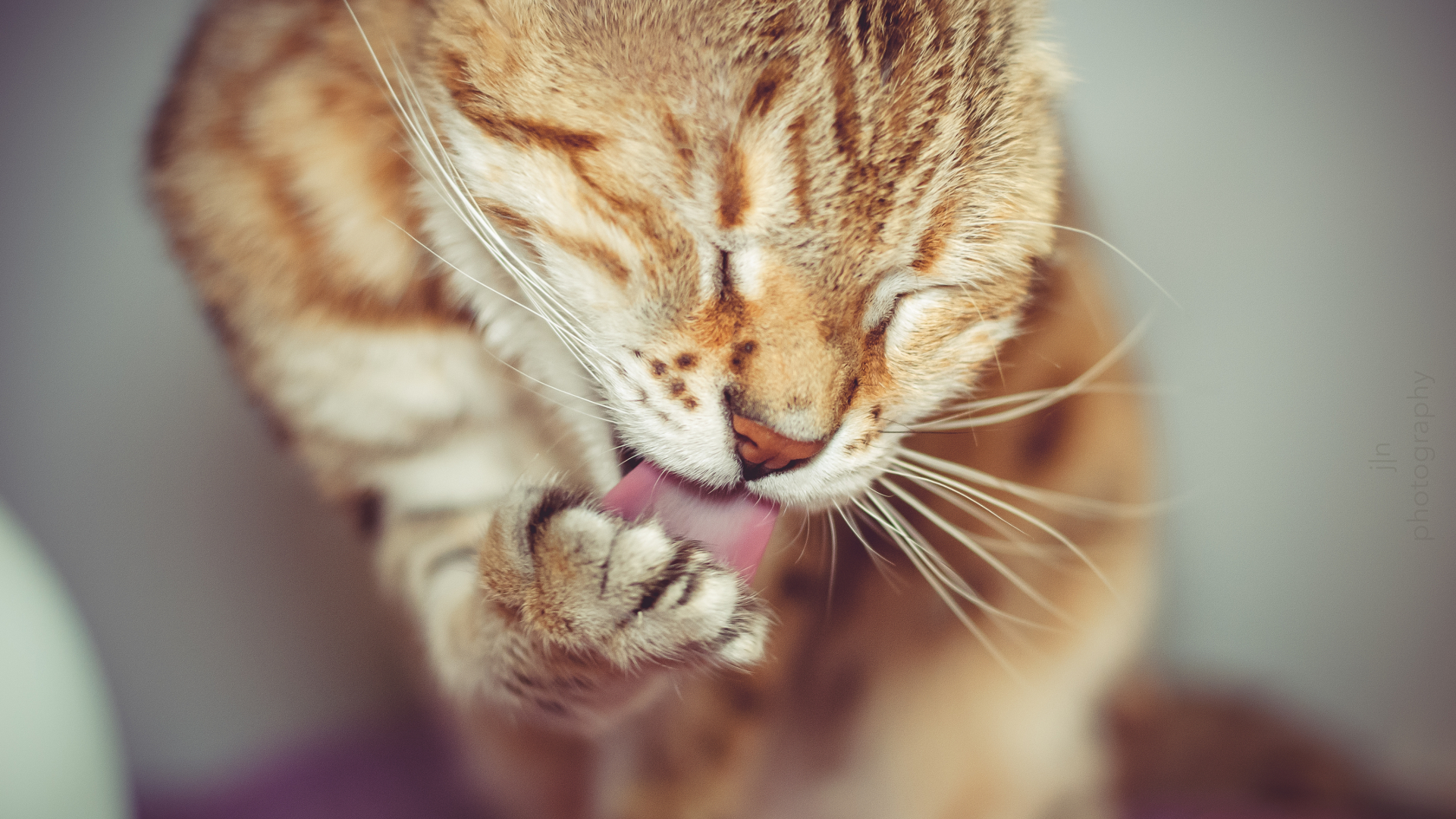Provided by the Cornell Feline Health Center, Cornell University
Gastrointestinal parasitism is a common problem in cats, with prevalence rates as high as 45 percent. The parasites can be wormlike (e.g., stomach worms, roundworms, hookworms, tapeworms) or one-celled (e.g., Isospora, Giardia, Toxoplasma) organisms. The signs associated with parasite infections are fairly nonspecific, such as a dull hair coat, coughing, vomiting, diarrhea, mucoid or bloody feces, loss of appetite, pale mucous membranes, or a pot-bellied appearance. The vomiting, diarrhea, anemia, and dehydration caused by intestinal parasites will weaken a cat, making it more susceptible to viral and bacterial infections and diseases; thus robbing your cat of good health. Furthermore, some parasites have the potential of infecting humans.
Wormlike Parasite
Roundworms
Roundworms (Toxascaris leonina and Toxocara cati) are the most common intestinal parasite of cats, with an estimated prevalence of 25% to 75%, and often higher in kittens. The adult roundworms are 3 to 5 inches long, cream-colored, and live in the cat’s intestine. The adult female worm produces fertile eggs that are passed in the infected cat’s feces. The eggs require several days to several weeks to develop into the infective larva stage.
Cats become infected with Toxocara cati by ingesting eggs or by eating rodents (transport hosts) that have larvae in their tissues. Kittens can become infected by larvae that are passed through an infected queen’s milk. In those cases, it is possible for kittens to become infected soon after birth. Cats become infected with Toxascaris leonina in a manner similar to Toxocara cati, but unlike Toxocara, the parasite is not transmitted through the milk.
Roundworm infections can potentially become life-threatening if the numbers are so great that intestinal blockage occurs. Usually, roundworm infections are relatively benign when compared to other intestinal parasites. However, infected kittens are in serious danger if left untreated. Diagnosis is confirmed by finding parasite eggs in the stool during microscopic examination. Many medications are effective, but reducing exposure to the feces of an infected cats and prohibiting hunting are the best means of prevention. Treatment of queens prior to breeding reduces the likelihood that the parasite will infect kittens.
Visceral larval migrans and ocular larval migrans are diseases caused by the migration of Toxocara larvae through the tissue of people, particularly children. Although these diseases are rare, they can be quite serious, especially when they occur in young children. They can be easily avoided by preventing ingestion of Toxocara eggs in contaminated soil or on the hands.
Hookworms
Hookworms (Ancylostoma and Uncinaria) are less than 1/2 inch long, slender, thread-like worms that as adults live in the cat’s intestine. Because of their small size, they usually are not visible in the feces of infected cats. Hookworms are long-lived and are capable of living as long as the cat. Less common than roundworm infections, the prevalence of hookworm infections in North America is estimated to be between 10% and 60%.
Adult cats usually become infected by larvae that penetrate their skin or that are ingested. Once the larvae gain entrance into the host, they migrate to the lungs and then to the intestines to develop into adult worms. It is uncertain whether cats can become infected by eating rodents containing larvae in their tissues, or ingesting queen’s milk that contain larvae.
Severe parasitism can cause anemia due to blood loss from the intestines where the worms attach themselves. The cat’s feces will appear black and tarry due to blood in the feces. If too much blood is lost, the cat can become anemic and may die if left untreated. Fortunately, like roundworms, these worms are easily diagnosed and treated. Good sanitation and daily cleaning of the litter box are keys to controlling hookworm infections.
Hookworm larvae can penetrate human skin. As they migrate under the skin, they cause a dermatitis called cutaneous larval migrans.
Tapeworms
Tapeworms (cestodes) have long flattened bodies that resemble a tape or ribbon. The body is comprised of a small head connected to a series of segments that are filled with eggs. The adult tapeworm lives in the small intestine with its head embedded in the mucosa. As the segments farthest from the head become fully mature, they break off and are passed in the feces. These segments can be observed near the cat’s tail and rectum, or in the feces. The segments are about one-quarter inch long, flat, and resemble grains of rice when fresh or sesame seeds when dry. When still alive they will usually move by increasing and decreasing in length. Microscopic examination of fecal samples may not always reveal the presence of tapeworms, because eggs are not passed singly, but as a group in the segments. Although the discovery of tapeworm segments can be quite alarming to cat owners, tapeworm infections only rarely cause significant disease in cats.
Cats usually become infected with tapeworms by ingesting infected fleas while grooming or by eating infected rodents. Fleas and rodents become infected by eating the tapeworm eggs that are in the environment. Modern medications are highly successful in treating tapeworm infections, but reinfection is common. Controlling the flea and rodent populations will reduce the risk of tapeworm infection in cats.
Some tapeworm species that infect cats can cause disease in humans if the eggs are accidentally ingested; but good hygiene virtually eliminates any risk of human infection.
Whipworms
Whipworms are an uncommon parasite of cats in the United States. Adult whipworms reside in the large intestine of infected cats but do not cause serious disease.
Stomach Worms
Ollanulus tricuspis and Physaloptera species are worms that can inhabit the feline stomach. Ollanulus infections occur only sporadically in the United States and are more common in free-roaming cats and those housed in multiple-cat facilities. Cats become infected by ingesting the parasite-laden vomitus of another cat. Chronic vomiting and loss of appetite, along with weight loss and malnutrition may be seen, although some infected cats show no signs of disease. Diagnosis of Ollanulus infection can be difficult, and depends upon detecting parasite larvae in the vomitus. The most effective treatment is not known; avoiding exposure to another cat’s vomitus is the most effective means of controlling infection.
Physaloptera infections are even more rare than Ollanulus infections. Adult female worms attached to the stomach lining pass eggs that are subsequently ingested by an appropriate intermediate host, usually a species of cockroach or cricket. After further development within the intermediate host, the parasite is capable of causing infection when a cat ingests the insect or another animal (a transport host), such as a mouse, that has eaten an infected insect. Cats infected with Physaloptera may experience vomiting and loss of appetite. Diagnosis relies upon microscopic detection of parasite eggs in the stool, or seeing the parasite in the vomitus. Effective treatment exists, and infection can be prevented by limiting exposure to intermediate and transport hosts.
Neither Ollanulus nor Physaloptera are capable of causing disease in humans.
Protozoan Parasites
Isospora
Isospora sp. (coccidia) are microscopic one-celled organisms causing the disease coccidiosis. Virtually all cats become infected with Isospora felis during their life. Cats become infected with this parasite by eating the cyst (thick-walled, egg-like stage) that has been passed in the feces and has matured in the soil. The cysts can be infective within six hours after being excreted in the feces.
Isospora infections usually cause no problems in adult cats, but evidence suggests that the parasite can cause significant disease in kittens. In infected kittens, the coccidia destroy the lining of the intestine and cause diarrhea with often contains mucous. Serious infections may develop in crowded environments. Good sanitation and hygiene will help control coccidia, but accurate diagnosis and effective treatment can only be achieved with your veterinarian’s assistance. Isospora of cats cannot cause disease in humans.
Giardia
Giardia are flagellated protozoa (one-celled organism) that parasitize the small intestine of cats. The prevalence of feline giardia infection (giardiasis) is estimated to be less than 5% but can be much higher in some environments. Cats become infected by ingesting giardia cysts present in the feces of another infected animal, usually a littermate or chronic carrier cat. Giardiasis is more common in multiple-cat households and catteries due to its mode of transmission. Also, the infection rate is greater in cats less than one year old.
The cysts are very resistant to freezing. Also chlorination of municipal water does not destroy the cysts. After ingesting of Giardia cysts, it takes 5 to 16 days before the cat will show signs of diarrhea. Acute or chronic, and continuous or intermittent diarrhea is the most common sign of infection, although the majority of Giardia-infected cats are free of disease. They do, however, remain a source of infection to other cats. The cat probably requires several exposures to the organism before infection actually occurs.
Diagnosis of giardiasis depends upon microscopic identification of cysts in the stool. For accurate diagnosis, several fecal samples may need to be evaluated since cysts are not continuously shed in the stool. Several effective medications are available, but resistance is common. Elimination of Giardia infections from households of cats may be difficult and depends on proper treatment and sanitation.
It is uncertain whether species of Giardia that infect cats are contagious to humans or vice versa. Careful hygiene will eliminate the risk of accidental ingestion of cysts.
Toxoplasma
Cats are the definitive host for the Toxoplasma organism. Infection with this protozoan parasite is fairly common, but actual disease caused by this parasite is relatively rare in cats. Cats can become infected by Toxoplasma by eating any of the three infective stages of the parasites. The most common route of infection is probably by ingestion of tissue cysts in infected prey or in other raw meat. Toxoplasma multiply in the small intestines and in approximately two to three weeks the oocysts are excreted in the infected cat’s feces. (For more detailed information on this parasite, see Toxoplasmosis.)
Treatment
Treatment may require administering one or more dosages of the medication prescribed by your veterinarian. Whenever using medications, be sure to carefully follow the directions provided by your veterinarian.
Parasite re-infections are very common, but can be prevented. Parasite control begins with good sanitation procedures. This includes daily removal of feces; washing the litter box with a disinfectant (e.g., diluted household bleach) on a regular basis; avoiding overcrowded conditions; avoiding diets with raw meats; and controlling intermediate hosts (fleas, ticks, and rodents). Good parasite control is the key to a healthier cat.








